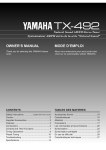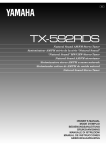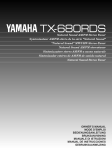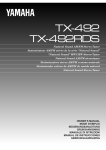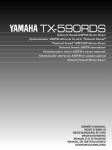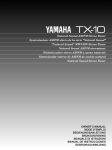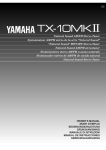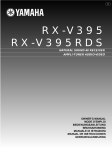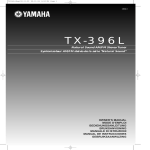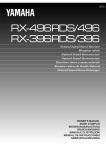Download Yamaha TX-300 Owner`s manual
Transcript
BG TX-592RDS Natural Sound AM/FM Stereo Tuner Syntonisateur AM/FM stéréo de la série “Natural Sound” “Natural Sound” MW/UKW-Stereo-Tuner Natural Sound AM/FM stereotuner Sintonizzatore stereo AM/FM a suono naturale Sintonizador estéreo de AM/FM de sonido natural Natural Sound Stereo Tuner OWNER’S MANUAL MODE D’EMPLOI BEDIENUNGSANLEITUNG BRUKSANVISNING MANUALE DI ISTRUZIONI MANUAL DE INSTRUCCIONES GEBRUIKSAANWIJZING SUPPLIED ACCESSORIES ACCESSOIRES FOURNIS MITGELIEFERTE ZUBEHÖRTEILE MEDFÖLJANDE TILLBEHÖR ACCESSORI IN DOTAZIONE ACCESORIOS INCLUIDOS BIJGELEVERDE ACCESSOIRES ● ● ● ● ● ● ● ● ● ● ● ● ● ● ● ● ● ● ● ● ● After unpacking, check that the following parts are contained. Après le déballage, vérifier que les pièces suivantes sont incluses. Nach dem Auspacken überprüfen, ob die folgenden Teile vorhanden sind. Kontrollera efter det apparaten packats upp att följande delar finns med. Verificare che tutte le parti seguenti siano contenute nell’imballaggio dell’apparecchio. Desembalar el aparato y verificar que los siguientes accesorios están en la caja. Controleer na het uitpakken of de volgende onderdelen voorhanden zijn. Indoor FM Antenna Antenne FM intérieure UKW-Innenantenne FM inomhusantenn Antenna FM per interni Antena FM interior FM Binnenantenne ● AM Loop Antenna Cadre-antenne AM MW-Rahmenantenne AM ramantenn Antenna AM ad anello Antena de cuadro de AM AM Lusantenne ● ● ● ● ● ● ● ● ● ● ● ● ● 2 Audio connection cord Câble de connexion audio Audio-Anschlußkabel Audio anslutningssladdar Cavo di collegamento audio Cable de conexión de audio Audio aansluitkabel 75-ohm/300-ohm antenna adapter (U.K. model only) Adaptateur d’antenne 75 ohms/300 ohms (Modèle pour le Royaume-Uni seulement) 75 Ohm/300 Ohm Antennenstecker (nur GroßbritannienModell) 75 ohm/300 ohm antennadapter (Endast modell för Storbritannien) Adattatore per antenna da 75 o da 300 ohm (Solo modello per la Gran Bretagna) Adaptador de antena de 75 ohmios/300 ohmios (Modelo para Reino Unido sólo) 75-ohm/300-ohm antenne-adapter (Alleen modellen voor Groot-Brittannië) • • • • • • • FEATURES CONTENTS Multi-Functions for RDS Broadcast Reception 40 Station Random Access Preset Tuning Automatic Preset Tuning for RDS Stations Multi-Status Station Memory Preset Station Shifting Capability (Preset Editing) Rotary Encoder Tuning Direct PLL Synthesizer Tuning SUPPLIED ACCESSORIES ...........................................2 CAUTION........................................................................3 CONNECTIONS .............................................................4 CONTROLS AND THEIR FUNCTIONS..........................7 TUNING OPERATIONS..................................................9 PRESET TUNING.........................................................10 RECEIVING RDS STATIONS .....................................13 TROUBLESHOOTING..................................................18 SPECIFICATIONS ........................................................19 English Thank you for selecting this YAMAHA stereo tuner CAUTION: READ THIS BEFORE OPERATING YOUR UNIT. 1. This unit is a sophisticated stereo tuner. To assure proper operation and the best possible performance, please read this manual carefully. 2. Choose the installation location for the unit carefully. Avoid placing it in direct sunlight or close to a source of heat. Also avoid locations subject to vibration and excessive dust, heat, cold or moisture. Keep it away from such sources of hum as transformers or motors. 3. Do not open the cabinet, because this may result in damage to the unit or electrical shock. If a foreign object should get into the unit, contact your local dealer. 4. When not planning to use this unit for long periods of time (ie., vacation, etc.), disconnect the AC power plug from the wall outlet. 5. To prevent lightning damage, disconnect the AC power plug and disconnect the antenna cable when there is an electrical storm. 6. When disconnecting the power plug from the wall outlet, always pull directly on the plug; never pull the cord itself. 7. Do not use force when operating switches and other controls. IMPORTANT Please record the serial number of this unit in the space below. Model: Serial No.: The serial number is located on the rear of the unit. Retain this Owner’s Manual in a safe place for future reference. WARNING TO REDUCE THE RISK OF FIRE OR ELECTRIC SHOCK, DO NOT EXPOSE THIS APPLIANCE TO RAIN OR MOISTURE. For U.K. customers If the socket outlets in the home are not suitable for the plug supplied with this appliance, it should be cut off and an appropriate 3 pin plug fitted. For details, refer to the instructions described below. Note: The plug severed from the mains lead must be destroyed, as a plug with bared flexible cord is hazardous if engaged in a live socket outlet. 8. When moving the unit, be sure to first disconnect the power plug and disconnect all wires connected from the unit to other equipment. 9. Do not attempt to clean this unit with chemical solvents, because this may damage the finish. Use a clean, dry cloth. 10. Be sure to read the “TROUBLESHOOTING” section of this manual for advice on common operating errors before concluding that the unit is faulty. 11. Keep this manual in a safe place for future reference. This unit is not disconnected from the AC power source as long as it is connected to the wall outlet, even if this unit itself is turned off. This state is called the standby mode. In this state, this unit is designed to consume a very small quantity of power. Special Instructions for U.K. Model IMPORTANT THE WIRES IN MAINS LEAD ARE COLOURED IN ACCORDANCE WITH THE FOLLOWING CODE: Blue: NEUTRAL Brown: LIVE As the colours of the wires in the mains lead of this apparatus may not correspond with the coloured markings identifying the terminals in your plug, proceed as follows: The wire which is coloured BLUE must be connected to the terminal which is marked with the letter N or coloured BLACK. The wire which is coloured BROWN must be connected to the terminal which is marked with the letter L or coloured RED. Making sure that neither core is connected to the earth terminal of the three pin plug. 3 CONNECTIONS Never plug in this unit and other components until all connections are completed. ANTENNA CONNECTIONS ● ● Each antenna should be connected to the designated terminals correctly, referring to the following figure. Both AM and FM indoor antennas are included with this unit. In general, these antennas will probably provide sufficient signal strength. Nevertheless, a properly installed outdoor antenna will give clearer reception than an indoor one. If you experience poor reception quality, an outdoor antenna may result in improvement. Outdoor FM antenna Outdoor AM antenna Indoor FM antenna (included) FM ANT GND AM loop antenna (included) AM ANT 75Ω UNBAL. 75-ohm antenna adapter 300-ohm feeder 75-ohm coaxial cable 4 75-ohm/300-ohm antenna adapter Ground English Connecting the indoor FM antenna Connecting the AM loop antenna 1 2 3 2 1 3 Orient so that the best reception is obtained. * If you connect an outdoor FM antenna to this unit, do not connect the indoor FM antenna to this unit. * The AM loop antenna should be placed apart from the main unit. The antenna may be hung on a wall. * The AM loop antenna should be kept connected, even if an outdoor AM antenna is connected to this unit. m Optional outdoor FM antenna Consult with your dealer or authorized service center about the best method of selecting and erecting an outdoor FM antenna. The choice of the feeder cable is also important. Flat ribbonshaped twin-lead cable performs well electrically, and is cheaper and somewhat easier to handle when routing it through windows and around rooms. Coaxial cable is more expensive, does a much better job of minimizing interference, is less prone to the effects of weather and close-by metal objects, and is nearly as good a signal conductor as feeder cable, particularly for foam-type coaxial cables. Coaxial cable is somewhat more difficult to install at the point where the cable enters the building. If coaxial cable is selected, make sure the antenna is designed to be used with that type of cable. 300-ohm feeder cable 75-ohm coaxial cable m Optional outdoor AM antenna In steel buildings or at a great distance from the transmitter, it may be necessary to install an outside long wire antenna. * Use a 75-ohm/300-ohm antenna adapter (not included) or a 75-ohm antenna adapter (not included) for connections. 300-ohm feeder cable 75-ohm coaxial cable 75-ohm/300-ohm antenna adapter 75-ohm coaxial cable 75-ohm antenna adapter Notes for FM antenna installation ● To minimize automobile ignition noise, locate the antenna as far from heavy traffic as possible. ● Keep the feeder cable or coaxial cable as short as possible. Do not bundle or roll up excess cable. ● The antenna should be at least two meters (6.6 feet) from reinforced concrete walls or metal structures. GND terminal For maximum safety and minimum interference, connect the GND terminal to a good earth ground. A good earth ground is a metal stake driven into moist earth. 5 CONNECTIONS TO THE AMPLIFIER ● ● Do not plug in this unit and the amplifier or other component until all connections are completed. Be sure that the connections from the left (“L”) and right (“R”) LINE OUT terminals are connected to the corresponding (left and right) input terminals of the amplifier or other component. ● If you have a YAMAHA amplifier whose terminals on the rear panel are numbered as 1, 2, 3, etc., connections can be made easily by making sure to connect the LINE OUT terminals of this unit to the input terminals of the amplifier numbered 2. Amplifier TUNER L R Connection cord (included) This unit (Europe model) FM ANT GND LINE OUT AM ANT 75Ω UNBAL. R L 2 To AC outlet NOTES ABOUT CONTROLLING THIS UNIT WITH THE REMOTE CONTROL TRANSMITTER This unit has a remote control sensor. It receives signals from a remote control transmitter provided with a YAMAHA amplifier or receiver. Remote control sensor Within approximately 6 m (19.7 feet) 30° 6 30° Notes ● There should be no large obstacles between the remote control transmitter and the main unit. ● If the remote control sensor is directly illuminated by strong lighting (especially an inverter type of fluorescent lamp etc.), it might cause the remote control transmitter not to work correctly. In this case, reposition the main unit to avoid direct lighting. English CONTROLS AND THEIR FUNCTIONS FRONT PANEL 1 2 NATURAL SOUND AM/FM STEREO TUNER 3 4 5 TX-592RDS TUNING 1 PRESET STATIONS 2 3 4 STANDBY/ON 5 RDS MODE/FREQ PTY SEEK MODE EON A/B/C/D/E START 6 MEMORY 7 EDIT 8 FM/AM MAN'L/AUTO FM TUNING MODE PTY SELECTOR AUTO/MAN'L MONO 6 7 8 9 0A B C 1 STANDBY/ON switch Press this switch to turn the power to this unit on. Press it again to turn this unit into the standby mode. Standby mode In this state, this unit consumes a very small quantity of power to receive infrared-signals from the remote control transmitter. 2 Display panel Shows station frequencies and various information. (Refer to the next page for details.) 3 Remote control sensor Receives signals from a remote control transmitter provided with a YAMAHA amplifier or receiver. 9 EON button Press this button to select a desired program type (NEWS, INFO, AFFAIRS, SPORT) when you want to call a radio program of that program type automatically. 0 A/B/C/D/E button Press this button to select a desired group (A–E) of preset stations. A MEMORY (MAN’L/AUTO FM) button When this button is pressed, the MEMO indicator flashes for about 5 seconds. During this period, press the desired PRESET STATIONS button to enter the displayed station into the memory. When this button is pressed and held for more than 3 seconds, the automatic preset tuning begins. (Refer to page 11 for details.) 4 PRESET STATIONS buttons Select a preset station number (1 to 8). B EDIT button 5 TUNING (PTY SELECTOR) control This button is used to exchange the places of two preset stations with each other. Used to tune in to a desired station. This control is also used to call a preset RDS station by program type. C FM/AM button 6 RDS MODE/FREQ button When an RDS station is received, pressing this button changes the display mode into the PS mode, PTY mode, RT mode and/or CT mode (if the station employs those RDS data services), and frequency display in turn. 7 PTY SEEK MODE button When this button is pressed, the unit turns into the PTY SEEK mode. D Press this button to switch the reception band to FM or AM. D TUNING MODE (AUTO/MAN’L MONO) button Press this button to switch the tuning mode to automatic or manual. To select the automatic tuning mode, press this button so that the “AUTO” indicator lights up on the display. To select the manual tuning mode, press this button so that the “AUTO” indicator goes off. 8 PTY SEEK START button Press this button to begin searching for a station after the desired program type is selected in the PTY SEEK mode. 7 DISPLAY PANEL 1 2 3 AUTO 4 5 ST KHz MHz EDIT MEMO PS PTY RT CT EON NEWS INFO AFFAIRS SPORT PTY HOLD 6 7 9 0 A 1 Preset station indicator 7 RDS mode indicators Display the group (A/B/C/D/E) and the number (1 to 8) of a preset station. 2 Station frequency display The name(s) of RDS mode(s) employed by the currently received RDS station light(s) up. Illumination of the indicator on the head of a name shows that the corresponding RDS mode is now selected. Displays the band and frequency or information from the received station. 8 EON indicator 3 AUTO indicator Lights up when an RDS station that employs the EON-PTY data service is received. Lights up when this unit is in the automatic tuning mode. 4 ST (STEREO) indicator 9 Program type name indicators The name selected in the EON mode lights up. Lights up when an FM stereo broadcast with sufficient signal strength is received. 0 PTY HOLD indicator 5 Signal-level meter Lights up while the search is performed in the PTY SEEK mode. Indicates the signal level of the received station. If multipath interference is detected, the indication decreases. A EDIT indicator 6 MEMO indicator When the MEMORY button is pressed, this indicator flashes for about 5 seconds. During this period, the displayed station can be programmed to the memory by using the A/B/C/D/E button and one of the PRESET STATIONS buttons. 8 8 Flashes by the first press of the EDIT button when you will exchange preset stations, and lights up for a moment by the second press of the EDIT button to show that the exchange has succeeded. Normally, if station signals are strong and there is no interference, quick automatic-search tuning (AUTOMATIC TUNING) is possible. However, if signals of the station you want to select are weak, you must tune to it manually (MANUAL TUNING). NATURAL SOUND AM/FM STEREO TUNER TX–592RDS TUNING PRESET STATIONS 2 3 1 1 4 STANDBY/ON 5 RDS MODE/FREQ PTY SEEK MODE EON START 6 A/B/C/D/E MEMORY 7 EDIT MAN'L/AUTO FM 8 FM/AM TUNING MODE AUTOMATIC TUNING 2 Turn the power on. PTY SELECTOR AUTO/MAN'L MONO 23 1 4 MANUAL TUNING 1 STANDBY/ON 2 Select the reception band (FM or AM) confirming it on the display. FM/AM Turn the power on. STANDBY/ON Select the reception band (FM or AM) confirming it on the display. FM/AM or 3 or 3 TUNING MODE AUTO/MAN'MONO 4 English TUNING OPERATIONS AUTO/MAN'MONO AUTO 4 Tune in to a desired station. TUNING To tune in to a higher frequency, slightly turn the control to the right. To tune in to a lower frequency, slightly turn the control to the left. * If the station where tuning search stops is not the desired one, turn again. * If the tuning search does not stop at the desired station (because the signals of the station are weak), change to the MANUAL TUNING method. TUNING MODE Turn the “AUTO” indicator off. Tune in to a desired station manually. TUNING Notes • If you tune to an FM station manually, it is received in monaural mode automatically to increase the signal quality. • When tuned in to a station, the frequency of the received station is shown on the display. If an RDS station that employs PS data service is received, the frequency is then replaced by the station name. Refer to page 15 for details. When you finish using this unit Press the STANDBY/ON switch again to turn this unit into the standby mode. 9 PRESET TUNING MANUAL PRESET TUNING This unit can store station frequencies selected by tuning operation. With this function, you can recall any desired station by only selecting the preset station number where it is stored. Up to 40 stations (8 stations x 5 groups) can be stored. 4, 2 NATURAL SOUND AM/FM STEREO TUNER TX–592RDS TUNING 1 PRESET STATIONS 2 3 4 STANDBY/ON 5 RDS MODE/FREQ PTY SEEK MODE EON START A/B/C/D/E 6 MEMORY MAN'L/AUTO FM 7 EDIT 8 FM/AM TUNING MODE PTY SELECTOR AUTO/MAN'L MONO 2, 1 3 To recall a preset station To store stations 1 2 1 Tune in to a desired station. (Refer to the previous page for tuning procedure.) Select the group of preset stations. A/B/C/D/E Select a desired group (A – E) of preset stations confirming it on the display. 2 A/B/C/D/E Select the preset station number. 1 3 5 7 8 MEMO Flashes on and off for about 5 seconds. Select a preset station number where you want to program the station before the “MEMO” indicator goes off from the display. 1 5 PRESET STATIONS 2 3 6 7 Notes A new setting can be programmed in place of the former one. • For presets, the setting of the reception mode (stereo or monaural) is stored along with the station frequency. • Memory back-up The memory back-up circuit prevents the programmed data from being lost even if this unit is turned into the standby mode or the power plug is disconnected from the AC outlet or the power is cut due to temporary power failure. If, however, the power is cut for more than one week, the memory may be erased. If so, it can be re-programmed by simply following the PRESET TUNING steps. 4 8 AUTO ST MHz Shows the displayed station has been programmed to A1. * In the same way, program other stations to A2, A3 ... A8. * You can program more stations to preset station numbers on other groups in the same way by selecting other groups in step 2. 10 6 4 MEMORY MAN’L/AUTO FM 4 PRESET STATIONS 2 3 English AUTOMATIC PRESET TUNING You can also make use of an automatic preset tuning function for RDS stations only. By this function, this unit performs automatic tuning and stores RDS stations with strong signals sequentially. Up to 40 stations are stored automatically in the same way as in the manual preset tuning method on page 10. NATURAL SOUND AM/FM STEREO TUNER TX–592RDS TUNING 1 PRESET STATIONS 2 3 4 STANDBY/ON 5 RDS MODE/FREQ PTY SEEK MODE START EON A/B/C/D/E 6 MEMORY MAN'L/AUTO FM 7 EDIT 8 FM/AM TUNING MODE PTY SELECTOR AUTO/MAN'L MONO 2 1 To store stations When the automatic preset tuning is finished 1 The display shows the frequency of the last preset station. Check the contents and the number of preset stations by following the procedure of the section “To recall a preset station” on page 10. FM/AM To recall a preset station Simply follow the procedure of the section “To recall a preset station” on page 10. A recalled station is shown by the frequency or station name on the display. 2 MEMORY MAN’L/AUTO FM Press and hold for more than 3 seconds. AUTO ST MHz MEMO Flashes. Notes ● The automatic preset tuning search is performed through all RDS network frequencies until stations are stored up to E8. If the number of received stations is not enough to be stored up to E8, the search will be finished automatically after searching all frequencies. ● With this function, only RDS stations with sufficient signal strength are stored automatically. If the station you want to program is weak in signal strength, tune to it in monaural manually and program it by following the procedure of the section “To store stations” on page 10. * There may be a case that this function cannot receive a station which could be received by the automatic tuning method. This is because this function receives a large volume of PI (Program Identification) data along with the station. ● If no station is received by the automatic preset tuning search, the search finishes after “NOTHING” flashes for about 3 seconds on the display. ● You can replace a preset station by another FM or AM station manually by simply following the procedure of the section “To store stations” on page 10. The automatic preset tuning begins from A1. Received stations are programmed to A1, A2 ... A8 sequentially. * If more than 8 stations are received, they are also programmed to the preset station numbers on other groups (B, C, D and E) in that order. 11 EXCHANGING PRESET STATIONS You can exchange the places of two preset stations with each other as shown below. NATURAL SOUND AM/FM STEREO TUNER TX–592RDS TUNING 1 PRESET STATIONS 2 3 4 STANDBY/ON 5 RDS MODE/FREQ PTY SEEK MODE START EON A/B/C/D/E 6 MEMORY 7 EDIT MAN'L/AUTO FM 8 FM/AM TUNING MODE PTY SELECTOR AUTO/MAN'L MONO 2, 4 Example) If you want to shift the preset station on E1 to A5, and vice versa. 1 Recall the preset station on E1 (by following the method of “To recall a preset station” on page 10). 4 EDIT 2 EDIT ST MHz EDIT Flashes. 3 Next, recall the preset station on A5 by following the same method with step 1. EDIT ST MHz EDIT Lights up for a moment. Flashes. Shows the exchange of stations is completed. 12 RDS (Radio Data System) is a data transmission system gradually being introduced by FM stations in many countries. Stations using this system transmit an inaudible stream of data in addition to the normal radio signal. RDS data contains various information, such as PI (Program Identification), PS (Program Service name), PTY (Program Type), RT (Radio Text), CT (Clock Time), EON (Enhanced Other Networks), etc. RDS function is carried out among the network stations. * This unit utilizes PI, PS, PTY, RT, CT and EON to receive RDS broadcast stations. English RECEIVING RDS STATIONS Displaying RDS data AUTO PS PTY RT CT EON ST SPORT This unit can be turned into the following five modes to display RDS data. PS (Program Service name) mode: CT (Clock Time) mode: Displays the name of the RDS station now being received instead of the frequency. Displays current time. This signal comes from the RDS station now being received. PTY (Program Type) mode: EON (Enhanced Other Networks) mode: Displays the type of the program on the RDS station now being received. There are 15 program types to classify RDS stations. Refer to the next page for details. RT (Radio Text) mode: Automatically receives a program of the designated program type when its broadcast starts, in place of the program now being received. When the broadcast of the called program ends, the previously received program (or another program on the same station) is recalled. Displays information about the program (such as title of the song, name of the singer, etc.) on the RDS station now being received. 13 Program types in the PTY mode NEWS News: Short accounts of facts, events and publicly expressed views, reportage and actuality. AFFAIRS Current affairs: Topical program expanding or enlarging upon the news, generally in different presentation style or concept, including documentary debate, or analysis. INFO Information: Program whose purpose is to impart advice in the widest sense, including meteorological reports and forecasts, consumer affairs, medical help, etc. SPORT Sport: Program concerned with any aspect of sport. EDUCATE Education: Program intended primarily to educate, of which the formal element is fundamental. DRAMA Drama: All radio plays and serials. CULTURE Culture: Programs concerned with any aspect of national or regional culture, including religious affairs, philosophy, social science, language, theatre, etc. SCIENCE Science: Programs about the natural sciences and technology. 14 VARIED Varied: Used for mainly speech-based programs usually of light-entertainment nature, not covered by above categories. Examples are: quizzes, panel games, personality interviews, comedy and satire. POP M Pop: Commercial music, which would generally be considered to be of current popular appeal, often featuring in current or recent record sales charts. ROCK M Rock: Contemporary modern music, usually written and performed by young musicians. M.O.R. M M.O.R.: (Middle of the Road Music). Common term to describe music considered to be “easylistening”, as opposed to Pop, Rock or Classical. Music in this category is often but not always, vocal, and usually of short duration (<5 min.) LIGHT M Light classics: Classical Musical for general, rather than specialist appreciation. Examples of music in this category are instrumental music, and vocal or choral works. CLASSICS Serious classics: Performances of major orchestral works, symphonies, chamber music etc., and including Grand Opera. OTHER M Other music: Musical styles not fitting into any of the above categories. Particularly used for specialist music, of which Jazz, Rhythm & Blues, Folk, Country, and Reggae are examples. English Changing the RDS modes When an RDS station is received, “PS”, “PTY”, “RT” and/or “CT” that correspond to the RDS data services employed by the station light up on the display. By pressing the RDS MODE/FREQ button once or more, you can change the display mode among the RDS modes employed by the received station in the order shown below. (The RDS mode not employed by the station cannot be selected.) Illumination of the indicator on the head of a name of RDS mode shows that the corresponding RDS mode is now selected. * When an RDS station is received, do not press the RDS MODE/FREQ button until one or some names of RDS modes light up on the display. If the button is pressed before one or some names light up on the display, the mode cannot be changed. This is because the unit has not received all of the RDS data on the station yet. * If no name of RDS mode lights up on the display, the mode cannot be changed. RDS MODE/FREQ PS mode The name of the station being received is displayed. If the station does not employ the PS data service, this mode will not be selected. PTY mode The type of the program on the station being received is displayed. If the station does not employ the PTY data service, this mode will not be selected. (You can make this unit search for a station which is broadcasting a program of your desired program type. For details, refer to the next page.) RT mode Information about the program on the station being received is displayed. Information is displayed by a maximum of 64 Roman Alphabets including umlaut sign. If other characters are used on the RT data, they are displayed with under-bars. If the station does not employ the RT data service, this mode will not be selected. CT mode Current time is displayed in the following form. The CT data from the station being received changes every minute. Hour Minute If the data is accidentally cut off, “CT WAIT” may light up. If the station does not employ the CT data service, this mode will not be selected. Frequency display mode The frequency of the station being received is displayed. Notes • RDS data service cannot be utilized by this unit if the received signal is not strong enough. Especially, the RT (Radio Text mode) needs much data to be received, so it may occur that RT mode cannot be displayed even if other RDS modes (PS, PTY, etc.) are displayed. • There may be a case that RDS data reception is not possible due to poor reception conditions. If so, press the TUNING MODE button so that the “AUTO” indicator goes off from the display. Though the reception mode is changed to monaural by this operation, when you change the display to an RDS mode, RDS data may be displayed. • If the signal strength gets weakened by external interference during receiving an RDS station, the RDS data service may be cut off suddenly and “...WAIT” will light up on the display. 15 Calling a program of your desired program type from among preset RDS stations (PTY SEEK) By designating a program type, the unit automatically searches all preset stations for an RDS station which broadcasts a program of that program type. * There are 15 program types to classify RDS stations. For details, refer to page 14. NATURAL SOUND AM/FM STEREO TUNER TX–592RDS TUNING 1 PRESET STATIONS 2 3 4 STANDBY/ON 5 RDS MODE/FREQ PTY SEEK MODE EON START A/B/C/D/E 6 MEMORY MAN'L/AUTO FM 7 EDIT 8 FM/AM PTY SELECTOR TUNING MODE AUTO/MAN'L MONO 13 1 Turn the unit into the PTY SEEK mode. 3 2 Begin searching all preset RDS stations. PTY SEEK MODE START PTY SEEK MODE START Flashes. * The program type of the station now being received or “NEWS” flashes on the display. AUTO PS PTY RT CT 2 Select the desired program type. PTY HOLD Flashes. TUNING * The “PTY HOLD” indicator lights up on the display. • • • If a station which broadcasts a program of the program type is found, the unit stops at the station and the program type lights up. If the station has PS data, after that, it turns into the PS mode. If the called station is not the desired one, press the PTY SEEK START button once more. The unit begins searching for another station which broadcasts a program of the same program type. If no station is found, “NOTHING” appears and then returns to frequency display. If the station has PS data, after that, it turns into the PS mode. * If the PTY SEEK START button is pressed once more during searching, this mode is canceled and turns into the frequency display. If the station has PS data, after that, it turns into the PS mode. To cancel this function 16 If the PTY SEEK MODE button is pressed once more, the PTY SEEK mode is canceled and turns into the frequency display. If the station has PS data, after that, it turns into the PS mode. English Making this unit call a program of your desired program type automatically when its broadcast starts This function uses the EON (Enhanced Other Networks) data service on the RDS station network. By only selecting a desired program type (NEWS, INFO, AFFAIRS or SPORT), this unit automatically searches all preset RDS stations for a station that broadcasts a program of that program type in the background, and, if found, receives a program when its broadcast starts in place of the program now being received. * This function can be used only when an RDS station that employs the EON-PTY data service is received. (When such a station is received, the “EON” indicator lights up on the display.) NATURAL SOUND AM/FM STEREO TUNER TX–592RDS TUNING 1 PRESET STATIONS 2 3 4 STANDBY/ON 5 RDS MODE/FREQ PTY SEEK MODE EON START A/B/C/D/E 6 MEMORY MAN'L/AUTO FM 7 EDIT 8 FM/AM PTY SELECTOR TUNING MODE AUTO/MAN'L MONO 2 1 Make sure that the “EON” indicator is illuminated on the display. 3 When the broadcast of the called program ends, the previously received program (or another program on the same station) is recalled. PS PTY RT CT EON PS PTY RT CT EON * If the “EON” indicator is not illuminated on the display, receive an (or another) RDS station so that the “EON” indicator lights up on the display. To cancel this function 2 Select a desired program type, NEWS, INFO, AFFAIRS or SPORT. Press the EON button once or more, so that no program type name lights up on the display. EON PS PTY RT CT EON NEWS Press once or more. Lights up. The search is performed among all preset RDS stations in the background. If a program is found, the program is automatically received when its broadcast starts. PS PTY RT CT EON NEWS Flashes. 17 TROUBLESHOOTING If the unit fails to operate normally, check the following points to determine whether the fault can be corrected by the simple measures suggested. If it cannot be corrected, or if the fault is not listed in the SYMPTOM column, disconnect the power cord and contact your authorized YAMAHA dealer or service center for help. SYMPTOM The FM antenna should be put up as high as possible, away from the road, and a coaxial cable used. Noise from thermostats or other electrical equipment. Attach a noise suppressor to the equipment causing the noise. FM stereo reception is noisy. Because of the characteristics of FM stereo broadcasts, this is limited to cases where the transmitter is far away or the antenna input is poor. Check the antenna connections. Try using a high quality directional FM antenna. Set the TUNING MODE button to the manual tuning mode. The ST indicator flickers and reception is noisy. Insufficient antenna input. Use an antenna appropriate for the reception condition in your area. Not tuned correctly. Tune again. There is distortion and clear reception cannot be obtained even with a good FM antenna. There is multipath interference. Adjust antenna placement to eliminate multipath interference. No stereo effect even with a stereo broadcast. The TUNING MODE button is set to the manual tuning mode. Set the button so that the “AUTO” indicator lights up on the display. A desired station cannot be tuned in with Automatic tuning. The station is too weak. Use the manual tuning mode. Use a high quality directional FM antenna. Previously preset stations can no longer be tuned in. The tuner has been unplugged for a long period. Repeat the presetting procedure. Insufficient sensitivity. Weak signal or loose antenna connections. Tighten the AM loop antenna connections and rotate it for best reception. GENERAL AM A desired station cannot be tuned in with Automatic tuning. 18 REMEDY Ignition noise from passing vehicles. Crackling sounds from time to time (especially in weak signal areas). FM CAUSE Use the manual tuning mode. There are continuous crackling and hissing noises. These noises result from lightning, fluorescent lamps, motors, thermostats and other electrical equipment. Use an outdoor antenna and a ground wire. This will help somewhat but it is difficult to eliminate all noises. There are buzzing and whining noises (especially in the evening). Another station is interfering with the received station. This is impossible to remedy. A television set is being used nearby. Relocate this unit away from the TV. There is an influence of strong external noise (lightning, excessive static electricity, etc.) or a misoperation on this unit while using this unit. Turn this unit into the standby mode and disconnect the AC power cord from the AC outlet. After about 30 seconds have passed, connect the power and operate this unit again. It happens that this unit does not work normally. English SPECIFICATIONS FM SECTION AM SECTION Tuning Range ...................................................87.5 to 108 MHz Tuning Range ..................................................531 to 1,611 kHz Usable Sensitivity (DIN) 75 ohms Mono (S/N 26 dB) ...........................................0.9 µV 75 ohms Stereo (S/N 46 dB)...........................................24 µV Usable Sensitivity ........................................................200 µV/m Selectivity (two signals, 40 kHz Dev., ±300 kHz) ..............70 dB Harmonic Distortion; 1 kHz .................................................0.3% Signal-to-Noise Ratio (DIN-Weighted) Mono (40 kHz Dev.) ........................................................75 dB Stereo (40 kHz Dev.) .....................................................70 dB Output Level (30% mod. 1 kHz) .....................................200 mV Signal-to-Noise Ratio.........................................................50 dB GENERAL Harmonic Distortion (1 kHz) Mono ................................................................................0.1% Stereo...............................................................................0.2% Power Supply ..........................................................230V, 50 Hz Power Consumption ..............................................................7W Stereo Separation (1 kHz) .................................................50 dB Frequency Response 20 Hz to 15 kHz .........................................................0±1.5 dB Dimensions (W x H x D) ...............................435 x 86 x 289 mm (17-1/8” x 3-3/8” x 11-3/8”) Weight ..........................................................3.2 kg (7 lbs. 1 oz.) Output Level 40 kHz Dev. .................................................................500 mV Accessories .............................................Audio connection cord AM loop antenna Indoor FM antenna 75-ohm/300-ohm antenna adapter (U.K. model only) * Specifications subject to change without notice. 19 YAMAHA YAMAHA YAMAHA YAMAHA YAMAHA YAMAHA YAMAHA ELECTRONICS CORPORATION, USA 6660 ORANGETHORPE AVE., BUENA PARK, CALIF. 90620, U.S.A. CANADA MUSIC LTD. 135 MILNER AVE., SCARBOROUGH, ONTARIO M1S 3R1, CANADA ELECTRONIK EUROPA G.m.b.H. SIEMENSSTR. 22-34, 25462 RELLINGEN BEI HAMBURG, F.R. OF GERMANY ELECTRONIQUE FRANCE S.A. RUE AMBROISE CROIZAT BP70 CROISSY-BEAUBOURG 77312 MARNE-LA-VALLEE CEDEX02, FRANCE ELECTRONICS (UK) LTD. YAMAHA HOUSE, 200 RICKMANSWORTH ROAD WATFORD, HERTS WD1 7JS, ENGLAND SCANDINAVIA A.B. J A WETTERGRENS GATA 1, BOX 30053, 400 43 VÄSTRA FRÖLUNDA, SWEDEN MUSIC AUSTRALIA PTY, LTD. 17-33 MARKET ST., SOUTH MELBOURNE, 3205 VIC., AUSTRALIA VZ90830 Printed in France Errata/Errata/Druckfehlerverzeichru’s /Rättelser/Errata corrige/Fe de errata/Errata PRESET MEMO PS PTY R MEMO PS PTY R PRESET English The “PRESET” indicator does not light up on the display panel in any status of this unit. Please ignore all descriptions and illustrations of the “PRESET” indicator in this manual. Français L’indicateur “PRESET” ne s’allume pas sur le panneau d’affichage sous aucune condition. Ne faites pas attention à touts les descriptions et illustrations relatives dans ce manuel. Deutsch Die senderspeicheranzeige “PRESET” leuchtet auf keinen Fall von diesem Gerät. Bitte ignorieren Sie alle Beschreibungen und Abbildungen von dieser Anzeige “PRESET” in dieser Bedienungsanleitung. Svenska “PRESET”-indikatorn tänds inte alls på displayen i någon av enhetens funktioner. Ignorera därför alla beskrivningar och illustrationer beträffande “PRESET”-indikatorn i denna bruksanvisning. Italiano L’indicazione “PRESET” non compare mai sul pannello delle indicazioni di questo apparecchio, quale che sia la condizione dell’apparecchio stesso. Ignorare tutte le descrizioni e illustrazioni di questo manuale relative all’ indicazione “PRESET”. Español El indicador “PRESET” no se enciende en la pantalla sea cual sea el estado de este aparato. Ignore todas las descripciones y figuras que se refieren al indicador “PRESET” a lo largo de este manual. Nederlands De “PRESET” indicator zal bij geen van de bedrijfstoestanden van dit apparaat op het displaypaneel oplichten. Veronachtzaam derhalve alle beschrijvingen en illustraties van de “PRESET” indicator in deze handleiding. V282660





















